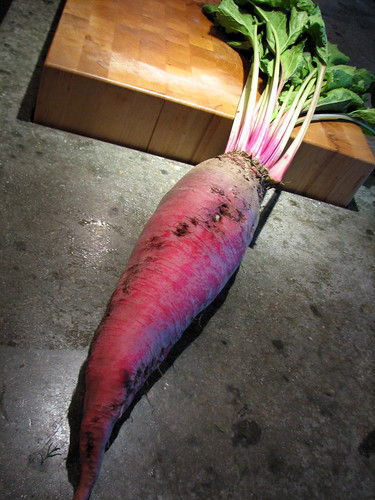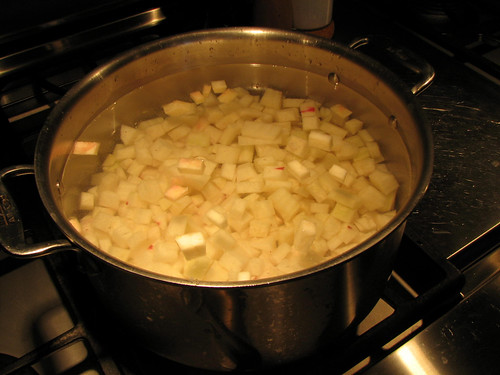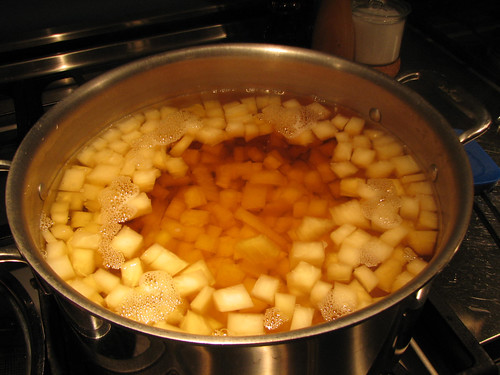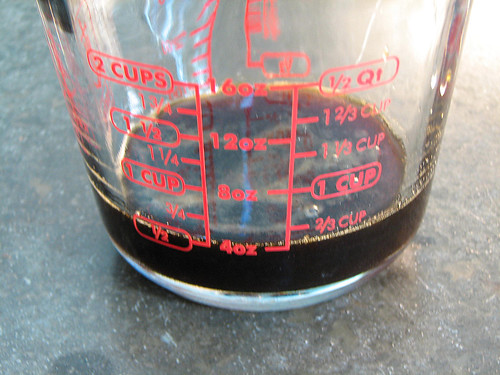Wednesday, September 17, 2008
Making Sugar at Home. Yes, Really.
I think I've told you before about how I like to know stuff. About my daily, constant quest for learning on any subject. I just can't help myself...it's like a reflex, and it's not at all unusual for me to suddenly find myself having spent two or three hours reading up on something completely, utterly useless. Interesting (to me), but useless.
I guess I'm just insatiably curious for no particular reason other than I think I like those light bulb moments when seemingly random bits of information on unrelated subjects fit together and another tiny little piece of the universe clicks into place in my brain.
Anyway.
I was that kid who asked all the insane questions. That kid who made you wonder just how the heck kids come up with such bizarre stuff and where the heck their parents were, and the one you could get to do something or go looking for an answer just by wondering about it out loud. So when our weekly CSA newsletter arrived the other day with the teaser "...we have open pollinated sugar beets available for making your own sugar. Let me know how many you want.", my natural response was to be interested and curious and to ask myself just how one would go about making sugar from beets on a small scale.
Hello, Google, dear friend.
Not surprisingly, it's a fairly simple process and one that seemed like it could be easily adapted to the home kitchen. But the one thing I couldn't find any information on was yield. Just how much sugar does one get from a pound of beets? It rang in my head like a plague.
So when I got to the farm to pick up our CSA share and came across Greg, our farmer, that question was one of the first things out of my mouth. And like all good teachers, he wondered along with me and then insisted I take a beet home in case I wanted to actually try making sugar to find out.
Meet the beet, just a few minutes and one county over from where it was (organically) growing:

This one was about the size of a newborn. I decided it looked like a French breakfast radish on steroids. I didn't try them, but Greg said the greens are bitter.
I got it trimmed and peeled and chopped it into a medium dice. Thinly slicing was another recommended option, although in hindsight I should have just run the whole thing through with the grating disk on my food processor. Either way, the point is surface area. I ended up with about 8 cups of diced beet, into a stock pot with twice that amount of water:

I tasted it as I was chopping, expecting to taste sweet, but found that it was much, much less sweet than the kind of beets that are intended for eating and with a slightly bitter aftertaste.
I set the whole thing to boil for an hour while I took PupCake for a walk. When we got back, it looked like this:

as you can see, the cooking water has definitely changed color. At this point I thought the water would taste sugary but it was basically like potato or pasta cooking water with a slightly more vegetable-y flavor, meaning it basically tasted like nothing.
I strained out the beet pieces and reserved them, having read they can be used in baking cakes or breads (presumably like zucchini). In an industrial setting the cooked beet pulp is pressed to extract the remaining sucrose-containing liquid and the solids are used for animal feed.
After another hour of boiling, my whole house was like a humid, vegetable-smelling swamp and the liquid was reduced by half and looked like this:

It still didn't taste anything but the very slightest bit sweet. The predominant flavor was of vegetable.
Reduced again by half and into a smaller pan:

Darker and more concentrated but still very little flavor. If anything, the predominant flavor is now salt. How weird.
And finally, the thickened liquid reduced as far as I have the patience for:

Scraping down the sides of the pan got a tiny bit of weirdly flavored "caramel" that hardened when cool. It tasted sweet but much less so than pure sugar with a lot of other strange mineral/vegetable flavor. Like sugary Marmite, maybe.
The end result from a single raw beet:

Just under half a cup of beet "molasses". Actually, it's still only about half as viscous as regular molasses or honey here, so I think a quarter cup of end product would be a more accurate statement of yield. If one were to attempt to turn this into a dry product, it would probably be more like a tablespoon. Because of what is evidently a high percentage of things other than C12H22O11 molecules, I'm not sure this would have ever crystalized but I think it could have been spread out on a Silpat and dehydrated in the oven (or a food dehydrator) and then pulverized with a mortar and pestle to get closer to sugar as we know it.
So, in my kitchen, from six or seven pounds down to a tablespoon with a couple of hundred thousand BTU's worth of natural gas and a gallon of water thrown in not counting the dirty dishes. And in an industrial setting, plus or minus a couple of gallons of petroleum products to grow and process that genetically modified beet. Yowza. That's a lot of energy expended for a tablespoon of sugar. Makes making maple syrup look like a fairly cheap and easy walk in the park. And honey? The jackpot of green, low effort sweeteners.
I'll never look at a chocolate chip cookie the same way again.
I guess I'm just insatiably curious for no particular reason other than I think I like those light bulb moments when seemingly random bits of information on unrelated subjects fit together and another tiny little piece of the universe clicks into place in my brain.
Anyway.
I was that kid who asked all the insane questions. That kid who made you wonder just how the heck kids come up with such bizarre stuff and where the heck their parents were, and the one you could get to do something or go looking for an answer just by wondering about it out loud. So when our weekly CSA newsletter arrived the other day with the teaser "...we have open pollinated sugar beets available for making your own sugar. Let me know how many you want.", my natural response was to be interested and curious and to ask myself just how one would go about making sugar from beets on a small scale.
Hello, Google, dear friend.
Not surprisingly, it's a fairly simple process and one that seemed like it could be easily adapted to the home kitchen. But the one thing I couldn't find any information on was yield. Just how much sugar does one get from a pound of beets? It rang in my head like a plague.
So when I got to the farm to pick up our CSA share and came across Greg, our farmer, that question was one of the first things out of my mouth. And like all good teachers, he wondered along with me and then insisted I take a beet home in case I wanted to actually try making sugar to find out.
Meet the beet, just a few minutes and one county over from where it was (organically) growing:

This one was about the size of a newborn. I decided it looked like a French breakfast radish on steroids. I didn't try them, but Greg said the greens are bitter.
I got it trimmed and peeled and chopped it into a medium dice. Thinly slicing was another recommended option, although in hindsight I should have just run the whole thing through with the grating disk on my food processor. Either way, the point is surface area. I ended up with about 8 cups of diced beet, into a stock pot with twice that amount of water:

I tasted it as I was chopping, expecting to taste sweet, but found that it was much, much less sweet than the kind of beets that are intended for eating and with a slightly bitter aftertaste.
I set the whole thing to boil for an hour while I took PupCake for a walk. When we got back, it looked like this:

as you can see, the cooking water has definitely changed color. At this point I thought the water would taste sugary but it was basically like potato or pasta cooking water with a slightly more vegetable-y flavor, meaning it basically tasted like nothing.
I strained out the beet pieces and reserved them, having read they can be used in baking cakes or breads (presumably like zucchini). In an industrial setting the cooked beet pulp is pressed to extract the remaining sucrose-containing liquid and the solids are used for animal feed.
After another hour of boiling, my whole house was like a humid, vegetable-smelling swamp and the liquid was reduced by half and looked like this:

It still didn't taste anything but the very slightest bit sweet. The predominant flavor was of vegetable.
Reduced again by half and into a smaller pan:

Darker and more concentrated but still very little flavor. If anything, the predominant flavor is now salt. How weird.
And finally, the thickened liquid reduced as far as I have the patience for:

Scraping down the sides of the pan got a tiny bit of weirdly flavored "caramel" that hardened when cool. It tasted sweet but much less so than pure sugar with a lot of other strange mineral/vegetable flavor. Like sugary Marmite, maybe.
The end result from a single raw beet:

Just under half a cup of beet "molasses". Actually, it's still only about half as viscous as regular molasses or honey here, so I think a quarter cup of end product would be a more accurate statement of yield. If one were to attempt to turn this into a dry product, it would probably be more like a tablespoon. Because of what is evidently a high percentage of things other than C12H22O11 molecules, I'm not sure this would have ever crystalized but I think it could have been spread out on a Silpat and dehydrated in the oven (or a food dehydrator) and then pulverized with a mortar and pestle to get closer to sugar as we know it.
So, in my kitchen, from six or seven pounds down to a tablespoon with a couple of hundred thousand BTU's worth of natural gas and a gallon of water thrown in not counting the dirty dishes. And in an industrial setting, plus or minus a couple of gallons of petroleum products to grow and process that genetically modified beet. Yowza. That's a lot of energy expended for a tablespoon of sugar. Makes making maple syrup look like a fairly cheap and easy walk in the park. And honey? The jackpot of green, low effort sweeteners.
I'll never look at a chocolate chip cookie the same way again.
Labels: cooking food making sugar
Comments:
<< Home
You remind me of me. And I come by my innate curiousity from my mother. Right now she is making home made soap from Lye because she wants to do it the 'old fashioned' way.
Thanks for trying this experiment... After seeing the flickr pictures I had to drop by to find out more!
So interesting.
What did you end up using the vegemite flavoured syrup for??
I bet it would be great in a batch of bran muffins and help to keep them moist.
Thanks for trying this experiment... After seeing the flickr pictures I had to drop by to find out more!
So interesting.
What did you end up using the vegemite flavoured syrup for??
I bet it would be great in a batch of bran muffins and help to keep them moist.
I was just listening to an interview with a scientist on NPR last night - he talks about how a kids natural curiosity is scientist in the making - dropping peas on the floor is an exercise in physics and gravity, so on an so forth.
It's nice to see some of us never get over our childlike curiosity of the natural world.
Interesting experiment - makes you appreciate the "simple things" in life a bit more, huh?
It's nice to see some of us never get over our childlike curiosity of the natural world.
Interesting experiment - makes you appreciate the "simple things" in life a bit more, huh?
Awesome. I have thought this many times before, but I really do wish I lived next door to you. I think we would spend all of our time running back and forth doing experiments and cooking and doing crafty things.
I was definitely brought up in a go-look-it-up-and-try-it-out-and-figure-it-out kind of house where science experiments were the norm. This is completely because of my mom whose love of discovery and research is only matched by her love to create. It was a wonderful childhood.
I was definitely brought up in a go-look-it-up-and-try-it-out-and-figure-it-out kind of house where science experiments were the norm. This is completely because of my mom whose love of discovery and research is only matched by her love to create. It was a wonderful childhood.
Interesting experiment but I suspect you failed it at the very beginning. Are you sure that your beet was the proper type? I mean your beet looks gorgeus but its shape and pinkish colour suggests that it is for feeding animals and not for producing sugars. All the real "sugar beets" I have seen so far were not pinkish but whitish and not so long but more stout and roundish in appearance. By the way I think the real sugar beets contain about 15-18% sugar. Yes, that much! Otherwise it would not be economical to process them - as you learned too. :-)
Quite possibly, yes. This was an organically grown, open pollinated, non-GMO sugar beet. I'm certain that sugar beets grown for commercial sugar production are genetically modified hybrids and undoubtedly they require regular treatment with pesticides and chemical fertilizers to grow.
First I have to say I stumbled on this page while looking for info I lost when my grandmother passed. I grew up on a farm where we had our own organic garden and we planted and refined sugar beets one year. The ones we grew were the whitish color mentioned above and 2-3 beets produced 2-2.5 cups of molasses. That beet in the picture does not look at all like we grew, and your yield seems to be a little low. I agree that that beet looks like cattle fodder. We only did it the one year and I was quite young but I remember it tasting just like molasses and my gram using it for her cookies.
Post a Comment
<< Home












